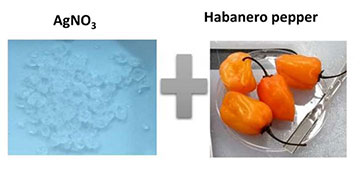
Silver nanoparticles are synthesized with the help of habanero peppers. Adapted from J. Nanophotonics, doi: 10.1117/1.JNP.14.036012. [Image: SPIE]
As a bulk material, silver’s shiny, reflective nature is useful for making mirrors or in jewelry. But on the nanometer scale, the tiny metal particles have unique optical, thermal and electronic properties that lend them to applications ranging from antimicrobial coatings to biosensing. This versatility has driven recent research toward devising new ways to synthesize these plasmonic nanomaterials.
Now, researchers at two Mexican universities have devised a surprisingly spicy method to do just that. Using habanero peppers as a secret ingredient, the team at the University of Guadelajara and the Univeristy of Colima have demonstrated a simple, affordable, eco-friendly method for biosynthesizing silver nanoparticles (J. Nanophotonics, doi: 10.1117/1.JNP.14.036012).
Seeking greener silver
The most common way to create silver nanoparticles is through chemical reduction of the salt AgNO3. Ions from the salt are reduced in solution to form metallic silver atoms; these then aggregate into clusters that form silver particles. However, this process comes at an environmental cost—the chemical reagents used to reduce and stabilize the salt concentration can be toxic for humans and the environment.
Biological reduction, a greener synthesis option, relies on organic products rather than chemical reagents—and scientists have used everything from garlic to green tea to biosynthesize the tiny metallic particles. Using plants and fruits in this process can have the added benefit of adding antioxidants into the mix, which, the researchers write, promotes the reduction of silver ions and increases the formation of silver nanoparticles.
In the current work, the researchers focused on a plant both chock-full of antioxidants and important to Mexico’s agro-economic system—the habanero pepper. “The most important goal is to have an eco-friendly and renewable methodology,” says coauthor Eden Oceguera-Contreras at the University of Guadalajara. But he notes that habaneros have the added benefit of being endemic to Mexico and capable of being produced in greenhouse conditions.
A peppery infusion
![]()
[Image: Getty Images]
In experiments, the researchers prepared a spicy dilution of silver nitrate and a habanero-pepper infusion. They noted that the solution’s color shifted from transparent to deep yellow, which, according to previous research, suggests the presence of silver nanoparticles. Spectroscopy also revealed that the solution had an absorption peak in the visible–ultraviolet around 400 nm—a characteristic of silver nanoparticles in suspension.
The team tested out two solutions with different molar concentrations of silver nitrate, 0.001 M and 0.005M, which resulted in solutions with different absorption peaks as well as different-sized nanoparticles. In the 0.005 solution, nanoparticles showed an absorption peak shifted toward a longer wavelength and larger particle sizes.
The researchers also monitored the pH and redox potential of the solutions in real time as the nanoparticles synthesized to discover the biomolecules’ role in the silver ion reduction. Then they used UV-Vis spectroscopy to confirm that the production of nanoparticles using habaneros was higher than with other methods.
Based on these results, they suggest that the antioxidants in habaneros help to stabilize the molecules through reducing and scavenging electrons—a mechanism that favors nanoparticle formation. According to Oceguera, “the more antioxidants the plant has, the more nanoparticles will be produced.”
Interdisciplinary implications
Next, the team would like to optimize the operational conditions for the production process, including pH, temperature and substrate concentration, with the goal of synthesizing the nanoparticles in a bioreactor. Thanks to the versatility of silver nanoparticles, Oceguera expects this research could have “multi and interdisciplinary implications,” impacting fields such as mechanical, chemical and bioprocess engineering, as well as molecular biology and physics.
